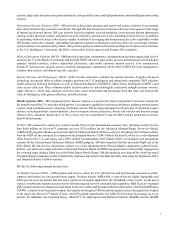Raytheon 2012 Annual Report Download - page 21
Download and view the complete annual report
Please find page 21 of the 2012 Raytheon annual report below. You can navigate through the pages in the report by either clicking on the pages listed below, or by using the keyword search tool below to find specific information within the annual report.13
ITEM 1A. RISK FACTORS
This Form 10-K and the information we are incorporating by reference contain forward-looking statements within the meaning
of federal securities laws, including information regarding our financial outlook, future plans, objectives, business prospects,
products and services, trends and anticipated financial performance including with respect to our liquidity and capital resources,
our backlog, our pension expense and funding, the impact of new accounting pronouncements, our unrecognized tax benefits
and the impact and outcome of audits and legal and administrative proceedings, claims, investigations, commitments and
contingencies, as well as information regarding domestic and international defense spending and budgets. You can identify
these statements by the fact that they include words such as “will,” “believe,” “anticipate,” “expect,” “estimate,” “intend,”
“plan,” or variations of these words, or similar expressions. These forward-looking statements are not statements of historical
facts and represent only our current expectations regarding such matters. These statements inherently involve a wide range
of known and unknown uncertainties. Our actual actions and results could differ materially from what is expressed or implied
by these statements. Specific factors that could cause such a difference include, but are not limited to, those set forth below
and other important factors disclosed previously and from time to time in our other filings with the Securities and Exchange
Commission. Given these factors, as well as other variables that may affect our operating results, you should not rely on
forward-looking statements, assume that past financial performance will be a reliable indicator of future performance, nor use
historical trends to anticipate results or trends in future periods. We expressly disclaim any obligation or intention to provide
updates to the forward-looking statements and the estimates and assumptions associated with them.
We depend on the U.S. Government for a substantial portion of our business and changes in government defense spending
could have consequences on our financial position, results of operations and business.
In 2012, U.S. Government sales, excluding foreign military sales, accounted for approximately 73% of our total net sales.
Our revenues from the U.S. Government largely result from contracts awarded to us under various U.S. Government programs,
primarily defense-related programs with the Department of Defense (DoD), as well as a broad range of programs with the
Intelligence Community and other departments and agencies. The funding of our programs is subject to the overall U.S.
Government budget and appropriation decisions and processes which are driven by numerous factors, including geo-political
events, macroeconomic conditions, and the ability of the U.S. Government to enact relevant legislation, such as appropriations
bills and accords on the debt ceiling.
Since fiscal year (FY) 2010, funding for the DoD base budget (excluding funds for overseas operations such as Afghanistan)
has essentially flattened and has remained at approximately $530 billion. The long-range defense plans submitted with the
FY 2013 budget request indicated a decrease of approximately 1% in the DoD base budget from this level in FY 2013, followed
by modest increases thereafter. However, defense spending levels in the future are increasingly difficult to predict due to the
overall fiscal constraints of the U.S. Government and the challenges of enacting relevant legislation. In particular, whether
funding cuts required under the Budget Control Act of 2011 (BCA) are actually implemented or not will have a significant
impact on DoD funding levels in FY 2013 and beyond. Currently, the cuts required by the BCA, unless amended by law,
would reduce funding to the DoD by approximately $45 billion in FY 2013 and almost $500 billion over the FY 2013 - FY
2021 period. While the Congress and the Administration have until March 1, 2013 before these cuts are implemented, it is
not clear whether there will be an agreement to avert, either fully or in part, these cuts.
Significant changes in defense spending could have long-term consequences for our business, and any such significant changes
could have a material adverse effect on our results of operations, financial condition or liquidity. In addition, changes in
government priorities, policies and requirements could impact the amount or timing of program funding, which could negatively
impact our results of operations, financial condition or liquidity.
In addition, we are involved in programs that are classified by the U.S. Government, principally through our IIS and SAS
business segments, which have security requirements that place limits on our ability to discuss our performance on these
programs, including any risks, disputes and claims.
Our financial performance is dependent on our ability to perform on our U.S. Government contracts, which are subject
to uncertain levels of funding and termination.
Our financial performance is dependent on our performance under our U.S. Government contracts. While we are involved in
numerous programs and are party to thousands of U.S. Government contracts, the termination of one or more large contracts,
























